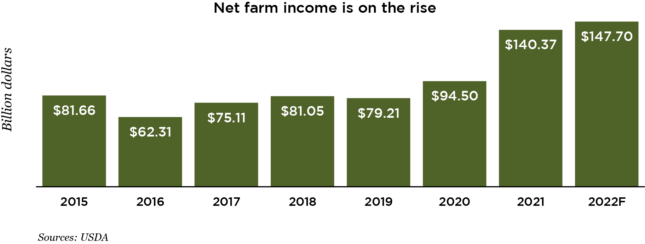Net farm income up despite high input costs
Healthy forecast for 2022 farm balance sheets
The USDA released its forecast for 2022 farm sector profits in early September. The forecast suggests that net income climbed this year, despite a drop in government pandemic-related subsidy payments. While expenses were up due to high input costs, the higher costs were outpaced by the sum of all forms of farm income.

Ag News Highlights
Drought causes rise in unplanted acres
A recent USDA report detailed the surge in the number of unplanted acres in California. Acres left fallow (unplanted to rejuvenate the soil) are down from 2021 but total unplanted acres are up 36 percent. This is due to intense drought conditions which are preventing farmers from planting as many acres as they otherwise would. Prevented acreage has more than doubled from a year ago and is more than five times what it was in 2020.
Some California farmers are having to abandon acreage, as well, as water restrictions have left them unable to water all their crops. On most farms, water preference is typically given to higher-value crops, such as tree nuts — a notoriously thirsty crop. Water limits, which have increased in recent years due to environmental policies, could intensify as drought conditions linger.
Ukrainian wheat planting expected to fall
Despite the reopening of three ports to allow Ukrainian grain back into the world market, much of Ukraine’s crops are still unable to leave the country. USDA’s 2022 forecast shows Ukraine, a significant contributor to the global market for wheat, harvesting 20.5 million tonnes of wheat this year and exporting 11 million tonnes. These totals fall well short of last year’s (25.4 and 16.9 million tonnes, respectively).
Diminished access to global demand means lower wheat revenues for Ukrainian farmers and, consequently, plans for reduced wheat planting this fall. The Ukrainian agriculture minister estimates that wheat sowing could be as much as 20 percent below normal. This could also mean continued elevated wheat prices in the global market as supply will be curtailed.
Ag barometer up; input costs still concerning
The Purdue University/CME Group Ag Barometer increased by 14 points in August, its largest increase in nearly two years. The rise in the index represents more confidence in both present and future conditions, but the index remains subdued compared to the long-run average. Input prices are still on the minds of farmers as over half of survey respondents said costs were the biggest concern for their farm over the next year and also represent the biggest deterrence to making large investments.
Citations/Disclaimers
-
The information in this report is provided by Nationwide Economics and is general in nature and not intended as investment or economic advice, or a recommendation to buy or sell any security or adopt any investment strategy. Additionally, it does not take into account any specific investment objectives, tax and financial condition or particular needs of any specific person.
The economic and market forecasts reflect our opinion as of the date of this report and are subject to change without notice. These forecasts show a broad range of possible outcomes. Because they are subject to high levels of uncertainty, they will not reflect actual performance. We obtained certain information from sources deemed reliable, but we do not guarantee its accuracy, completeness or fairness.

